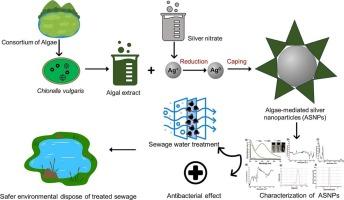Chlorella vulgaris-mediated sustainable biogenic synthesis of silver nanoparticles for wastewater remediation and antibacterial applications
Q1 Environmental Science
引用次数: 0
Abstract
This investigation examines the green synthesis of silver nanoparticles (SNPs) using Chlorella vulgaris as a reducing and stabilizing agent. Algae-mediated SNPs (ASNPs) were tested for the potential application in sewage water remediation and as an antibacterial agent. Biogenic ASNPs demonstrated excellent stability and a surface plasmon resonance (SPR) peak at 440 nm. Energy dispersive X-ray (EDAX) spectroscopy analysis and Fourier transform infrared (FTIR) spectroscopy investigation indicated the role of biomolecules originating from the algal extract, which play a crucial role in the green synthesis process of ASNPs. Dynamic light scattering analysis yielded a hydrodynamic mean particle size of 200 nm and a zeta potential of around 18 mV. Observation under electron microscopy presented the morphological diversity with a prominent signature of elemental silver in ASNPs. A domestic waste sewage sample collected from a sewage treatment plant presented elevated levels of alkalinity, salinity, and biological oxygen demand (BOD). ASNP treatment normalises most of the water parameters, while algal extract alone could produce minimal effects. The antibacterial evaluations against Staphylococcus aureus and Escherichia coli, well-known opportunistic pathogens responsible for a wide range of hospital and community-acquired infections, showed dose-dependent effects. These findings highlight the dual functional role of C. vulgaris-mediated SNPs as an effective, eco-friendly solution for both wastewater remediation and antibacterial application.

小球藻介导的可持续生物合成纳米银在废水修复和抗菌中的应用
本研究考察了以小球藻为还原剂和稳定剂的绿色合成纳米银(SNPs)。研究了藻类介导的SNPs (ASNPs)在污水修复和抗菌方面的潜在应用。生物源ASNPs表现出良好的稳定性和440 nm的表面等离子体共振峰。能量色散x射线(EDAX)光谱分析和傅里叶变换红外(FTIR)光谱研究表明,来自藻类提取物的生物分子在ASNPs的绿色合成过程中起着至关重要的作用。动态光散射分析得到的流体动力学平均粒径为200 nm, zeta电位约为18 mV。电镜观察显示,ASNPs具有明显的银元素特征。从某污水处理厂收集的生活污水样本显示碱度、盐度和生物需氧量(BOD)水平升高。ASNP处理使大多数水参数正常化,而藻类提取物单独产生的影响最小。金黄色葡萄球菌和大肠杆菌是引起广泛的医院和社区获得性感染的众所周知的机会致病菌,对这两种致病菌的抗菌评价显示出剂量依赖效应。这些发现强调了C. vulgaris介导的snp作为一种有效的、环保的废水修复和抗菌应用解决方案的双重功能作用。
本文章由计算机程序翻译,如有差异,请以英文原文为准。
求助全文
约1分钟内获得全文
求助全文
来源期刊

Bioresource Technology Reports
Environmental Science-Environmental Engineering
CiteScore
7.20
自引率
0.00%
发文量
390
审稿时长
28 days
 求助内容:
求助内容: 应助结果提醒方式:
应助结果提醒方式:


